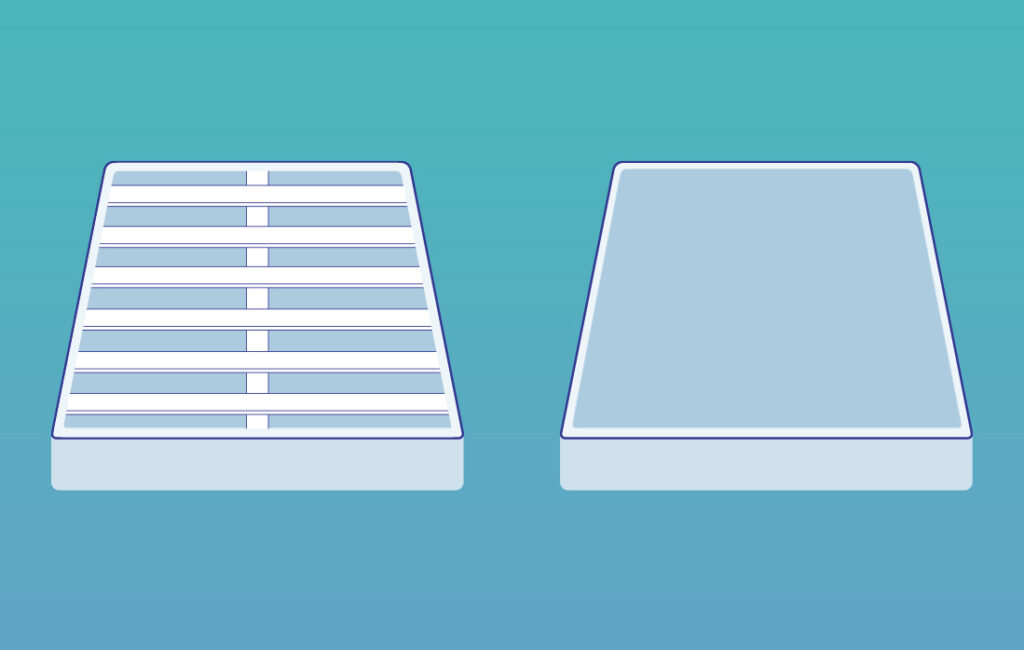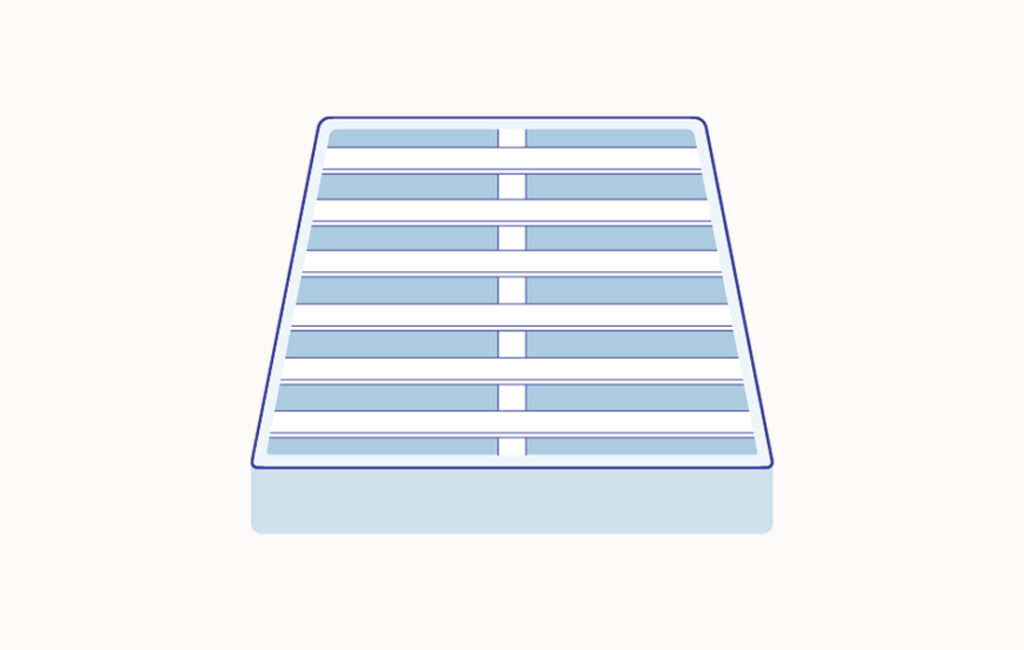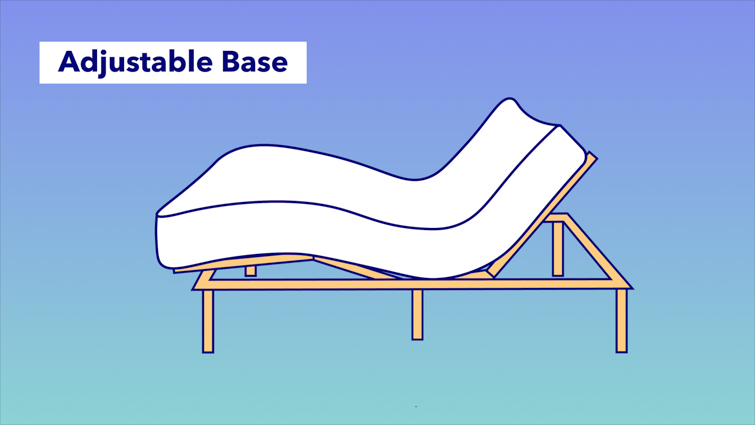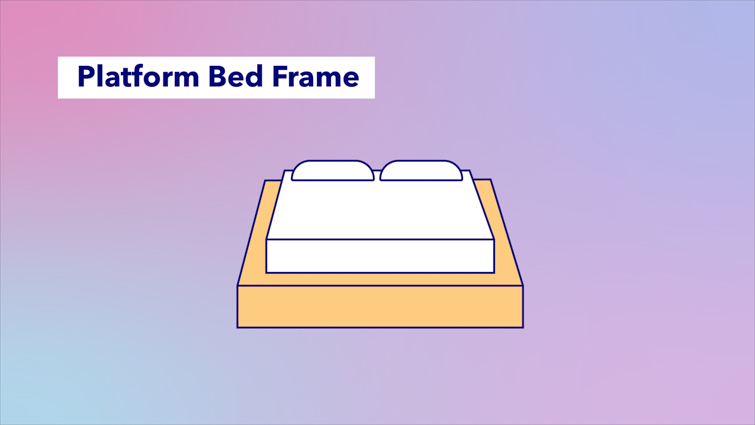
Soft or firm mattress? Box spring vs slats? There’s a lot to think about when you’re in the market for a new mattress or bed frame.
If you’re shopping for a new bed frame, you may be wondering about the difference between box springs and slats, and which is right for you. If so, rest easy. We’ll cover the ins and outs of each so you can shop slwith confidence for your new bed frame. You can also check out our mattress buying guide if you’re in the market for a new bed.
What are Bed Slats?
Wooden slats are a common feature of platform beds. They’re usually made of wood, but they can also be made from metal. They run horizontally across your bed and provide support for your mattress.
Think of them as similar to small planks connecting to each side of your bed frame, with a slight space — typically a few inches or less — in-between each slat.
Bed slats are often an attractive option because they allow room underneath your bed for storage space. If you’re looking to tuck things beneath your bed to store them out of sight, then bed slats may be a good choice.

Metal vs Wood Slats
So which is better when it comes to metal vs wooden slats? There are a few key differences between the two.
Wooden slats are preferable if you’re shopping on a budget because wooden slats are often less expensive than metal ones. But keep in mind, they’re also less durable.
If you’re looking for a bed frame that will stand the test of time, metal slats may be the way to go. Generally speaking, they’re less likely to bend or break. But keep in mind that durability will depend on the quality of the materials used.
Metal slats are also less likely to be damaged by termites. They have the added benefit of absorbing more weight so they’re better able to support a larger-size mattress.
One downside of metal slats, though, is they tend to creak more often than wooden ones. If you’re a light sleeper looking for a peaceful night’s sleep, wooden slats may be preferable.
Who are Slats Best For?
Bed slats are versatile and work well with most mattress types. That makes them an ideal choice for most anyone, regardless of whether you’re a back sleeper, stomach sleeper, or side sleeper.
However, bed slats work particularly well for hot sleepers. If you’re prone to waking up in the middle of the night and adjusting the thermostat because you feel warm, bed slats could help you feel more comfortable. Because bed slats promote airflow, they’ll help you keep your cool at night. Since they’re well-ventilated, they also prevent issues like mold and mildew buildup.
Hot sleepers: Check out our picks for the best cooling mattresses and cooling sheets of the year.
Pros & Cons of Bed Slats
When shopping for a bed frame, bed slats are a good option to consider. But before you settle on them, let’s go over both their benefits and drawbacks so you can make an informed decision.
Bed Slat Pros
- Budget-friendly. For shoppers looking to purchase a bed frame on a budget, bed slats can be gentle on your wallet.
- Durable. Looking for a bed frame that will last? Slatted frames will help you get the most bang for your buck. They’re durable and can support most mattresses.
- Easy to assemble. If you’re planning to purchase a bed frame that requires assembly, you may want to opt for a slatted frame. These are generally easier to put together and can save you time and frustration if you decide to go the do-it-yourself route.
Bed Slat Cons
- Potential sagging. Over time, your mattress may begin to sag in the empty space in-between the slats. To prevent this, be sure to check the manufacturer’s specifications for your particular mattress type. It should include guidance about recommended bed frames and whether there are any specific requirements when it comes to minimum spacing in-between slats. Some mattresses should also be rotated every so often to prevent the potential for sagging.
- Potential to be assembled incorrectly. While bed slats are typically easy to assemble, there’s a chance they could be assembled incorrectly as well. If improperly assembled, bed slats can shift or become loose.
- Possible shifting. Speaking of shifting, loose bed slats may damage your mattress, or worse, cause you injury. You may want to reinforce slats to prevent this from happening. A bunkie board, for instance, may help. More on that in just a bit.
What are Box Springs?
A box spring is a bed base usually with a wooden frame covered in fabric. It can either have coil springs or be hollow on the inside.
Box springs are typically positioned between your mattress and bed frame. They can be used to raise a mattress or provide additional support. Whereas bed slats may cause a mattress to sag, box springs provide a firm, flat, and even surface.
Box springs also support a ton of weight and provide more even weight distribution. If you toss and turn during the night, a box spring will help absorb some of that movement. Box springs also improve airflow, keeping you cooler at night.

Who are Box Springs Best For?
Generally speaking, box springs can work for all types of sleepers. However, since they raise the height of your mattress, they may work especially well for taller people or those who simply prefer the aesthetic of a higher profile bed.
It’s important to note, though, that box springs will not work for all mattress types. They typically work best with lightweight innerspring mattresses rather than memory foam or latex mattresses.
When in doubt, be sure to check the manufacturer’s specifications for your mattress to confirm whether or not it should be used with a box spring. While box springs don’t work with all mattress types, some mattress manufacturers actually require a box spring be used in order for the mattress to be eligible for warranty.
Pros & Cons of Box Springs
Just as with bed slats, box springs come with their own set of benefits and drawbacks. Here’s an overview of their pros and cons.
Box Spring Pros
- Great stability. Box springs absorb movement and provide additional protection for your mattress, helping to reduce wear and tear. Box springs may also prevent sagging, helping you to sleep more comfortably.
- Offers more height. If you like the aesthetic of high beds, box springs are a natural choice. But they also make it easier for taller people to get in and out of bed by reducing the need to bend down.
- Can add more bounce if it has coils. A box spring with coils offers extra bounce that helps your mattress absorb pressure, which can make it last longer.
Box Spring Cons
- Bulky. Box springs can be rather bulky and difficult to move. If you relocate or want to move your bed around, keep in mind that a box spring can be rather heavy and cumbersome to lift.
- Can be pricier. Box springs often cost more than bed slats. While they can increase the lifespan of your mattress, you should take into account your initial investment to determine whether a box spring is worth the higher price tag.
- No room for storage beneath them. If you want a bed with drawers or space underneath to stash your belongings, you may want to opt for a different mattress foundation. Read on to learn about some other options.
Slats vs Other Mattress Foundations
Want to know how slats measure up when compared to other foundation types? Here’s a rundown of some alternatives so you can get a sense of whether they may be preferable for you.
Bunkie Board
A bunkie board is a flat board, typically made of plywood or similar material, that sits between your mattress and bed foundation. It’s usually anywhere from one to three inches thick.
Bunkie boards can be used in place of a box spring when you’re looking for extra support without the extra height. They typically work for any size mattress or bed frame.
Bunkie boards can also be used on top of bed slats if your mattress needs to lie on a flat surface. Just keep in mind that bunkie boards generally reduce airflow so they may not be the ideal choice for hot sleepers.

Adjustable Base
Just as the name suggests, this type of base can be adjusted so the top or bottom of your bed can be raised or lowered to your preferred height.
Enjoy reading a few chapters of a good book before you go to sleep? Resting your back against a wall or bed frame may be rather uncomfortable. You can raise the top of the bed to provide back support as you read and then lower it when you’re ready to go to sleep.
Likewise, adjustable beds can help you sleep more comfortably. If you’re prone to back pain, for instance, you can adjust the position of your bed to accommodate your preferred sleeping position. If you have mobility issues, lowering your bed can also help you climb in and out of it more easily. Elevating your head or body while asleep may also help you breathe easier at night by taking pressure off your airway.

Platform Beds
Platform beds provide adequate support for your mattress, eliminating the need for a box spring. Your mattress can sit directly on top of your bed frame instead. Platform beds also come in an array of materials and styles. If you want to maximize bedroom space, for instance, many platform beds include room for storage.
While platform beds are versatile and work with most any interior design, they may not be suitable for all sleepers. For example, sleepers who prefer a softer surface may find platform beds are too firm. They also tend to sit lower to the ground so if you prefer a bed with more height, you may want to opt for another foundation type.

Solid Foundation
Solid foundations are similar to bed slats because they consist of wooden boards or beams. Unlike bed slats, however, these boards have no space in-between. Because the boards form a solid foundation, they can prevent your mattress from sagging. Solid foundations work well with latex, memory foam, and hybrid mattresses.
The Right Bed Height For You
Keep in mind that whatever mattress foundation you choose affects your bed’s total height. For instance, bed slats typically sit lower to the ground than box springs. So what’s the best bed height for you?
The average knee height for most adults is 16 to 24 inches, so generally speaking, you want to have a bed height that falls somewhere in that range. But keep in mind that ideal bed height also depends on other factors, such as whether you have mobility issues, prefer the aesthetic of a high or low-profile bed, or want extra space for storage.
FAQs
Are slats the same as a box spring?
Both box springs and bed slats are types of bed foundations. However, they are not the same thing. You can use them in combination with each other or you can use each of them on their own.
Can you use slats instead of a box spring?
You can absolutely use bed slats in place of a box spring. Just be sure to check the manufacturer’s warranty for your mattress to see whether a box spring is recommended or required for warranty coverage.
Why are box springs no longer used?
Mattresses have evolved quite a bit. Modern day mattresses are thicker and provide better support than traditional mattresses so box springs are typically no longer necessary.
Is it okay to put a mattress on slats?
Yes, you can put a mattress directly on slats. Just be sure to check the manufacturer specifications for your mattress type to see if there are any specific guidelines you should follow.
Can you use a box spring with slats?
Yes, you can use a box spring with slats as long as the box spring is the right size.
How much weight can bed slats hold?
The amount of weight bed slats can support will vary, so be sure to check the manufacturer specifications. However, you can generally expect bed slats to hold anywhere from 300 to 600 pounds of weight.
Conclusion
There’s really no right or wrong answer when it comes to choosing a mattress foundation. As long as your mattress manufacturer approves the foundation/base to be used with your bed, it really comes down to personal preference and what’s best for you.
That being said, we’ve done the research to narrow down our top picks. Check out our reviews of some popular bed frames to see if there’s one that catches your eye. It may be just the one you need to catch some better shut-eye!



























